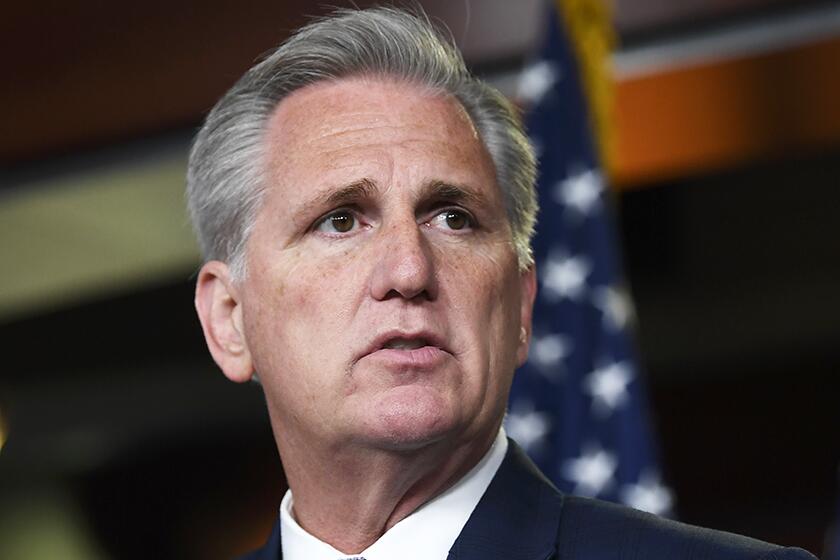Californians, here we go
IF BLUE-STATE Californians want to give the national Republican Party palpitations, here’s some practical advice: Go east, young man (or woman).
Just not too far east.
In fact, you might try right next door. Any one of the eight red to purple states of the nation’s interior West -- Arizona, Colorado, Idaho, Montana, Nevada, New Mexico, Utah or Wyoming -- would do just fine.
Although California’s 55 electoral votes have proved impotent to thwart the rise of a big-government-loving, big-religion-thumping GOP, the California diaspora into some of our nation’s least populous states is looking like it just might do the trick.
The GOP has tilted too far toward its Southern wing, preoccupied as it is with religion, tradition and morality, and away from its Western wing, which is more concerned with freedom, independence and privacy.
The result is a party that has all but abandoned socially liberal but fiscally conservative voters, leaving it increasingly vulnerable in states where libertarian-leaning voters are a presence. If you take the 2004 presidential election results in three of the Four Corners states (Colorado, where President Bush won by 5 percentage points; Nevada, where he won by 3; and New Mexico, by 1), a total of fewer than 70,000 votes would have swung 19 electoral votes and the election to John Kerry.
And it is former Californians who may end up being the force that brings the GOP’s whole Mountain West advantage tumbling down.
Three demographic trends are converging to turn our red mountains purple. First, there’s the growing Latino population throughout the West. True, Bush has done OK with these voters, getting about 40% nationwide in 2004. But the GOP is in the midst of an anti-immigrant conniption, and Latino voters still identify with the Democratic Party by a margin of roughly thee to one.
Second, the states of the interior West are generally less religious than those of the South. Evangelicals make up 29% to 34% of the populations in the eight Mountain West states (Utah, with its large Mormon population, is an exception). That compares with 73% in Mississippi, 51% in Texas and 44% in Kansas.
Third -- and related to the first two trends -- the interior West is filling up with migrants from the Golden State. Picture a bucket of blue paint on the coast overflowing and spilling east.
The trend is so pronounced that demographer William Frey says Arizona and Nevada “are essentially now becoming appendages of California.” Nevada stands out in particular, with 18% of its residents (as of the 2000 census) having been born in California. In Arizona, the number is 8%. The other Mountain states post some impressive numbers too: 9% of Idaho, 7% of Utah, 6% of Colorado and 5% of Montana. In New Mexico, where Bush won in 2004 by about 6,000 votes, 79,000 ex-Californians lived there as of 2000.
So, who are these migrants?
People who can’t afford to live in California anymore, Frey says, typically Generation-X types in search of jobs and affordable homes.
“A lot of them are from very blue parts of California,” he told me. “My gut feeling,” he said, is that migrant Californians “will hold on to their cultural ideas” even if their economic needs might change. Even “red” Californians leaving the state as part of “white flight” aren’t likely to be anywhere near as socially conservative as voters from the South.
This suggests that Democrats may begin to have an easier time making their case in the West. And recent election results may bear this theory out. Whereas in 2000 Democrats held zero out of eight governorships in the interior West, they now hold four -- including the statehouse in Montana, which Brian Schweitzer won in 2004, the first Democrat to do so in 20 years.
In 2004, Democrats also took over both houses of the Colorado Legislature and sent Democrat Ken Salazar to the Senate to replace retiring Republican Sen. Ben Nighthorse Campbell; Salazar’s brother, John, won the open House seat in Colorado’s 3rd District, which was vacated by a Republican (one of only two open Republican seats picked up by Democrats that year).
In 2006, Democrats have strong pickup possibilities in the races for the Colorado and Nevada governorships. Sen. Conrad Burns in Montana, a Republican tied tightly to the Jack Abramoff lobbying scandal, is extremely vulnerable. And House races in Arizona, Colorado, Nevada and New Mexico have become unexpectedly rough for Republicans.
In the past, Republicans have gotten by on their ability to push Americans’ cultural hot buttons and on voters’ distrust of the Democrats when it comes to national security. But those kinds of appeals are going to be less and less effective in an interior West made up more and more by skeptical Californians.
Driving to the polls every election day may be satisfying to California’s liberal and libertarian-leaning voters. But it’s the folks who drive a state or two over and stay who will eventually force the Republican Party to choose between tipping over on its West-South axis and finding a more socially tolerant, fiscally responsible alternative.
More to Read
Get the L.A. Times Politics newsletter
Deeply reported insights into legislation, politics and policy from Sacramento, Washington and beyond. In your inbox three times per week.
You may occasionally receive promotional content from the Los Angeles Times.










